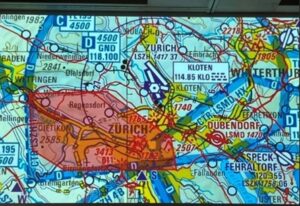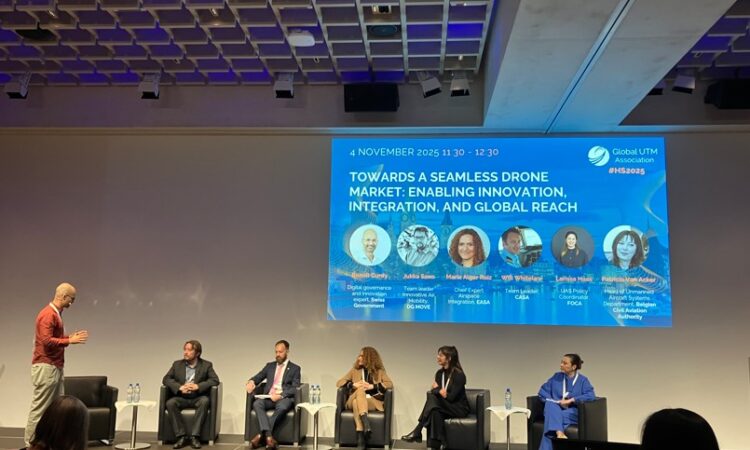By Claudia Bacco
The USA is moving ahead in the race to open the skies to beyond visual line of sight (BVLOS) drones flight as European regulations continue to frustrate efforts there.
That was one of the overriding messages of GUTMA’s annual Harmonized Skies event, held this year in Zurich on November 4-5.
Zipline shared some statistics related to its deployment in Dallas, Texas. On a recent Sunday, it supported more than 1,000 flights during a three-hour period flying BVLOS with unmanned traffic management (UTM). This isn’t a test; it’s a real deployment.

Zipline operations in Dallas, Texas. Source: Zipline
The FAA’s proposed rule Part 108 came up a few times in different panels as an example of the US taking a leadership role in opening up the skies to scale commercial drone traffic. On 5 August, a notice of proposed rulemaking in the US was opened for comments through 6 October. The proposed rule is intended to provide a predictable and clear pathway for safe, routine, and scalable UAS operations that include package delivery, agriculture, aerial surveying, civic interest, operations training, demonstration, recreation, and flight testing. In short, this expands BVLOS operations using a collision avoidance system, without the need to receive individual authorisation. Highlights of the very long Part 108 link shared above can be found here.
Manna’s CEO Bobby Healy joined the ABC of digital aviation panel and shared that the company’s 2026 growth plans will focus on the US and the UAE, due to regulatory contraints inhibiting growth in Europe. This is a strong statement in a public forum that shows the level of concern echoed throughout the conference related to growth opportunities in Europe for drone operators. Or should I say, lack of them.
In Europe, BVLOS progress seems to be stuck in a chicken or an egg situation where there is a need to fly drones to gather data to obtain regulatory approval for widespread BVLOS flight. But due to lack of regulatory approval the flights can’t take place at scale.
Koen De Vos kicked off the event with a challenge statement, “the future belongs to those who integrate and share data.” How do we get there?
There is some progress in Europe. The Switzerland Federal Office of Civil Aviation (FOCA) hosted the conference and set the stage for day one by sharing its current status related to the implementation of U-space in the Zurich area. Or should I say the status that there is no Zurich U-space yet, but a soft launch. It began the risk assessment process in 2023 and have three key factors in the area that made Zurich a good target for initial U-space launch: a strong local ecosystem, a dense complex airspace, and authorities/industry players who are committed to collaborate.

Zurich U-space. Source: Swiss FOCA
The ground risk assessment included seven hazard scenarios that were analysed and one quantified. The airspace risk assessment included nine hazard scenarios that were analysed, resulting in four scenarios and one sub-scenario being quantified. The original goal was to be able to announce that field testing had begun in November 2025, even at this event. Unfortunately, this is not the case. The new timeline is for field testing to be completed by the end of Q2, 2026 with additional air risk assessment, shadow mode testing and USSP certification continuing during this time. This would allow for shadow mode deployment to occur by the end of Q3, 2026 with full deployment following this.
Zurich will be one of the first U-space locations with multiple USSPs in the same airspace. Currently there are four USSPs working to pass all gates for this to occur. ANRA Technologies and Innov’ATM are certified USSPs, while Avision and Avielo have their USSP certification in process.
Standards – can we all just get along?
The standards and open-source panel raised another topic regarding the US and Europe which was the two standards bodies EUROCAE and ASTM and how they should be viewed. These organisations should be viewed as international and not just the US or Europe as they do work together and share lessons learned. Although it was noticeable that ASTM participated in the conference and EUROCAE did not. Seems like a missed opportunity to hear from the industry and build additional bridges.
Some of the questions discussed on the panel dedicated to standards considered the questions regarding the need for standards to be all things to all people and who should be working on them. Although the first topic wasn’t really answered, there was consensus that more industry participants need to be a part of standards efforts and today too many lawyers are sitting around the table who haven’t actually lived this topic on a day to day basis. The standards won’t get resolved without technical participation.
FOCA suggested that we just need to start implementing with what we have today, as we can’t keep waiting.
Equal opportunity airspace access
The last few conference sessions were held at the Switzerland Innovation Park which included demonstrations of some innovations by startups working in this programme. The last panel of the day, access to airpsace, considered the challenges currently faced by different industry players. FOCA highlighted the need for a ‘drone champion’ in Switzerland. A great analogy really brought this to light. Consider a sheet of paper with nails on it facing all different directions. How to align them, a magnet brings them in line. When will Switzerland have its magnet? Not to point the finger at Switzerland as it isn’t the only place that needs a magnet.
The Swiss Drone Competence Center stated that companies are leaving Switzerland or breaking the law to conduct BVLOS flight testing. Move to a country where it’s allowed or fly illegally and hope that you don’t get caught. Although an opportunity is presented by the alpine geography. The Drone Industry Alliance Switzerland shared that there is a lot of interest from operators abroad to test flying in an alpine environment. This would be an opportunity to attract more operators to this market.
Overall the conference was eye opening, if not concerning, to understand that we are still in a holding pattern. Many companies developing products for the drone market are holding on by a thread waiting to be able to conduct operations at scale and fulfill their strategic targets. Unfortunately, it seems there will be additional industry consolidation for companies who are putting all of their ‘eggs’ in the European basket. Maybe these chickens need to fly elsewhere for the winter and hope the regulators in Europe start 2026 with a new motivation to ensure the drone industry thrives and don’t risk falling behind other geographies around the world.




